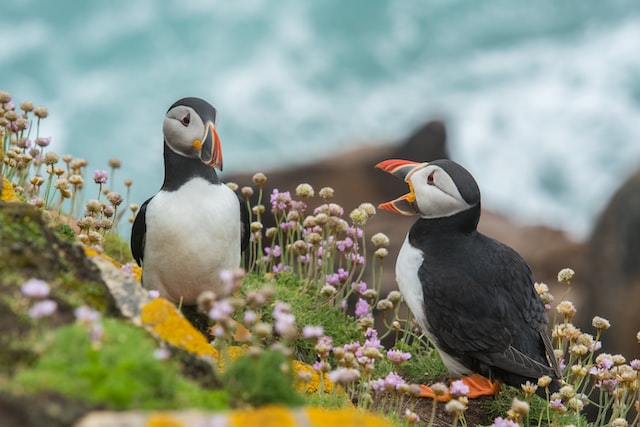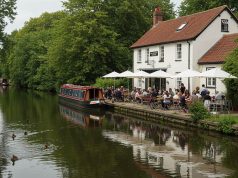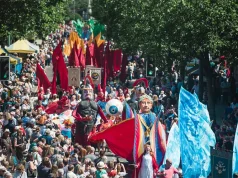
Britain is rich in beautiful wildlife, attracting many people yearly to witness the unique varieties of birds, animals, botanicals, and marine life. While some are now critically endangered due to habitat destruction and hunting, wildlife reserves have been working to preserve many species that are on the verge of endangerment.
If you’re visiting Britain or want to enjoy something other than urban life, all you need is its breathtaking wildlife to make you fall in love with Britain.
Birds
Britain has many winged friends as its visitors and inhabitants all year round, whether migratory or native to this place. While some are endangered, others are still prevalent, entertaining everyone with their colors and varying sounds.
1. Starling and Their Murmurations,
One of the sweetest and most beautiful natural phenomena to make you fall in love with Britain has to be the murmurations of the starlings. One of the common English birds, a swarm of starlings, performs magical swirlings and dances across the sky while singing when dusk falls.
You can observe this starling murmurations phenomenon during the coldest days of the British winter.
2. Puffins
An endangered European wildlife species, Puffins are easily recognizable from their clownish bill, yearning eyes, and properly pinned-up look. You can find most puffins in many places in Britain, such as Farne Islands, Bempton Cliffs, Sumburgh Head, and Skomer, and during the Amble Puffin Festival.
3. Green Woodpecker
Although spotting a green woodpecker is difficult, you can easily recognize one by its distinctive laughing call. Their beaks are softer compared to other woodpeckers, which is why you won’t find them making a drumming or drilling noise on a tree.
4. Pheasants
Pheasants are eye-pleasing for the striking patterns and colours on their feathers and the shape of their head. These birds have been used in games since they were brought to Britain by the Romans. You can easily spot a common pheasant in the woods from its loud shrieking call; however, golden pheasants are rare to spot.
Animals
In Britain, you’ll find animals that are not common in other parts of the world or are critically endangered. They live in various areas, from woods to mountains to waterbodies, some of which are included in the list below.
1. Grey Squirrels
Grey squirrels are one of the unique species in Britain, with their grey fur and fluffy tails. You can commonly spot these noisy creatures in hardwood forests, especially where nut trees are abundant. While strolling in such forests, you can hear them chattering pleasantly, sending mating calls during their two mating seasons, or making a loud sound warning of danger.
2. Barking Muntjac Deer
The muntjac deer, also known as the barking deer, makes their characteristic loud barking noises in September, mostly when they make their mating call and many other circumstances. You can often spot them, or at least hear them, in the woodlands of England, Scotland, and Ireland, making squeaking noises while leading a herd or screaming when they sense danger.
3. Pine Marten
Pine martens may look very innocent, but don’t be fooled by their looks and small size. This animal belongs to the same family of carnivorous mammals, badgers, otters, ferrets, and minks.
They have long fluffy tails and two-toned fur, with chestnut-brown on their head and body and off-white color on their neck.
4. Water Vole
Also known as water rats, water voles are large brown rodents similar to brown rats found in almost all waterways in Wales, England, and Scotland; however, they’re now critically endangered species. You can find them searching burrows on riverbanks to rest there at night and may also find them nibbling on stems and grass in one spot throughout the day.
Fish and Crustaceans
If you’re a fan of discovering marine life by diving, snorkeling, and rock pooling, the British shores will provide you with plenty of entertainment, even on the best driving routes. You’ll find striking crustaceans and unique-looking fish species here, so discover with your heart while diving in!
1. Basking Shark
Baskin sharks, the largest fish in The UK, have an enormous mouth with what looks like a skeletal structure inside when it opens its mouth. They migrate during summer and winter to find the best zooplankton grounds to feed on.
2. Spiny Squat Lobster
While snorkeling or diving along the coasts of The UK, you may find the mesmerizing site of spiny squat lobsters, mainly on the gravel and rocky depths of the northeast. You’ll be attracted to their bright red exterior with vibrant blue veins running across their shells. Although the largest squat lobster in The UK, this species is very shy and will quickly run away to a nearby shelter if you try approaching it.
3. Skeleton Shrimp
The skeleton shrimp has an ashen and translucent body, which is why many people also refer to it as the ghost shrimp. This species primarily lives around sponges and seaweed, making it a sight to witness when diving and snorkeling on various coasts of The UK. You’ll often find them clinging on to alga in large numbers, making them look like bubbles around marine plants and feeding on plankton and dead animals.
4. Gobies
Britain has a few varieties of gobies differing in their features and sizes, from large to small, elongated to shortened. Some of the gobies you’ll commonly find while snorkeling, rock pooling, and diving are two-spotted goby, painted goby, giant goby, and rock goby. Each type has its habitat and feeding ground, capable of camouflaging themselves within their natural habitat.
Insects

As weird as it may sound to some people, one of the most mesmerizing wildlife varieties, apart from plants and birds, exists among insects. You’ll find a wide range of beetles, wasps, flies, and butterflies here that may look straight out of a fairytale or a sci-fi movie.
1. Beetles
You may have seen some unique-looking beetles circulating across virtual media platforms, most of which are present in Britain, living in various habitats. Some of them are the green tiger beetle, the stag beetle, and the rose chafer beetle with its metallic color-shifting green exterior.
The minotaur and the common burying beetle also have unique features. The very rare timberman beetle may not look like a usual beetle, but it has long antennas and a long body.
2. Wasps
Wasps can be different in Britain compared to what we usually see, especially the gall wasp. This wasp has three reddish-pink balls as its body, with hairy spikes all around it. You’ll find them commonly on rose petals and leaves, looking like reddish-pink spiky lumps sitting on them.
The ruby-tailed wasp, also called the cuckoo wasp, is another spectacle you’ll find in Britain. Its tail has a ruby hue, while its body has a combination of emerald and sapphire tones.
3. Flies
Britain is home to flies barely seen anywhere else in the world. Take the hornet robber fly, the largest fly species in The UK that looks almost alien-like due to its thick legs and hornet-like structures. Although harmless to humans, this fly is venomous to other small insects.
The semaphore fly is prominently found across Wales and England. They’re widely known due to the mating stunts the male fly performs to attract females. They buzz their wings with white tips and display dance moves similar to fighting.
Botanical Life
Britain is rich in botanical life that you may not find anywhere else. There’s a lot to get lost in, from edible fungi to flowers, giving you more reasons to find Britain a brilliant place.
1. Berries
Britain has many unusual, luxurious berries you can barely find anywhere else. Japanese wineberries have a distinct red translucence with a grapy, winey flavor. Tayberry is a raspberry-blackberry cross, giving it a red color and elongated body.
Blue honeysuckles, also known as honeyberries, have a distinct blue color and an unusually long body. Chilean guava berries get their name from their similarities with guava, but also have bright red color and the usual berry juiciness.
Autun olives look much like olives but are small and red. They are also commonly used as nitrogen fixers for garden soils.
2. Orchids
Britain is home to many unique orchids that get their names from how they look. For example, lady orchids get their name from their shape, resembling ladies with tied-up hair and wearing spotted dresses.
Th ghost orchid doesn’t have chlorophyll and relies on specific fungi for its food instead of sunlight. The lady’s slipper orchid, also known as the ‘shoe of Venus’ and not to be confused with spider orchids, is named due to its shoe-like structure and striking colors.
3. Yellow Bird’s Nest
A weird, ghastly flower, the yellow bird’s nest is a parasitic flower that blooms by getting nutrients from a special kind of fungi. It has translucent petals everywhere and bows its head the more it grows, thus getting the name Dutchman’s pipe.
4. Bluebell
Although you can find it everywhere in Britain, it has been declared an endangered flower as its numbers are reducing because of habitat destruction and illegal trading of its bulbs. It’s also called the ancient fairy flower because it looks beautiful and is a native wildflower.
Conclusion
While you can view teh spectacles of British nature all year round, autumn and winter bring the best out of it. From birds to flowers to marine life, there’s a lot you can explore in its breathtaking wildlife to fall in love with Britain.
Go hiking or diving, or even take a stroll during sunset, and the birds and the grounds will surprise you with something unique every time.





